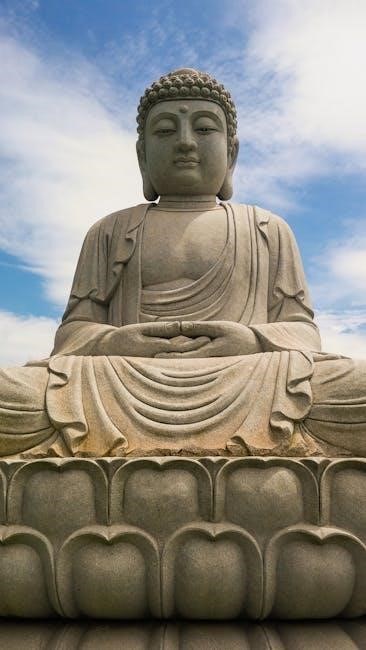Overview of “Zen in the Art of Archery”
Eugen Herrigel’s “Zen in the Art of Archery” blends Zen philosophy with Japanese archery, exploring mindfulness, focus, and spiritual unity, influencing cultural understanding and practice globally.
Eugen Herrigel’s Zen in the Art of Archery is a captivating blend of memoir and philosophical inquiry. The book recounts Herrigel’s journey as a Westerner immersed in Japan’s Zen tradition, exploring the spiritual dimensions of archery. Through his experiences with Kyudo, or Japanese archery, Herrigel delves into themes of mindfulness, focus, and the unity of the archer with the bow and target. This timeless work bridges Eastern philosophy and Western curiosity, offering insights into the Zen mindset and its application to both art and life, resonating deeply with readers worldwide since its 1953 publication.

1.2. Author and Publication Details
Eugen Herrigel, a German philosopher and cultural scholar, authored Zen in the Art of Archery, first published in 1953. Herrigel’s fascination with Zen Buddhism led him to Japan, where he studied Kyudo under Master Awa Kenzō. The book chronicles his six-year journey mastering archery while exploring Zen principles. Its unique blend of personal narrative and philosophical insight has made it a classic, offering a window into Japanese culture and the spiritual dimensions of art. Herrigel’s work remains influential, bridging East and West through its timeless themes.
1.3. Summary of Key Themes
The book explores the convergence of Zen philosophy and archery, emphasizing mindfulness, concentration, and the pursuit of spiritual unity. Herrigel delves into the concept of “It,” a state of effortless action, and the dissolution of the self. He illustrates how archery becomes a meditation, where the archer, bow, and target merge into a single, harmonious process. The themes of discipline, intuition, and transcendence are central, offering insights into both Zen practice and the art of Kyudo, while challenging Western perceptions of Eastern spirituality and its practical applications.

Historical Background of Zen and Archery
Zen Buddhism, introduced to Japan in the 12th century, deeply influenced arts like archery, transforming it into a spiritual practice. Kyudo evolved from a military skill to a meditative discipline, embodying Zen principles of focus and harmony, reflecting Japan’s cultural synthesis of spirituality and tradition.
2.1. Origins of Zen Buddhism in Japan
Zen Buddhism, originating from China as Chan, was introduced to Japan in the 12th century by Eisai and Dogen, becoming a cornerstone of Japanese spirituality. It emphasized meditation, self-discipline, and the pursuit of enlightenment through daily activities. Zen flourished during the Kamakura and Muromachi periods, deeply influencing Japanese culture, arts, and martial traditions, including archery. Its teachings of mindfulness and harmony with nature resonated with Japanese aesthetics, shaping the spiritual dimensions of practices like Kyudo, as explored in Herrigel’s work.
2.2. Evolution of Kyudo (Japanese Archery)
Kyudo, or Japanese archery, has its roots in the 12th century as a martial art and ceremonial practice. Originally used in warfare, it evolved into a spiritual discipline influenced by Zen Buddhism and Shinto. The bow became a symbol of harmony with nature and self-discipline. By the 16th century, Kyudo shifted from a practical weapon to a meditative art, emphasizing mental focus and ethical conduct. Herrigel’s exploration of Kyudo highlights its transformation into a modern sport and spiritual practice, blending technical skill with mindfulness and cultural heritage.
The Author’s Journey with Zen and Archery
Eugen Herrigel, a German philosopher, immersed himself in Zen Buddhism and Kyudo, discovering their profound connection. His journey transformed archery into a spiritual practice, blending technical mastery with inner peace and self-discovery.
3.1. Eugen Herrigel’s Experience with Zen
Eugen Herrigel, a German philosopher, delved into Zen Buddhism while in Japan, seeking to understand its essence. He chose archery (Kyudo) as a medium to explore Zen, believing his background in shooting would aid his learning. However, he soon discovered that Zen archery demanded more than technical skill—it required mental discipline, self-awareness, and letting go of ego. Under the guidance of his instructor, Awa Kenzō, Herrigel learned to embrace the concept of “It” (the spontaneous moment) and the unity of archer, bow, and target. His journey was marked by challenges, insights, and a profound transformation, which he detailed in his seminal work.
3.2. His Training in Kyudo
Eugen Herrigel’s training in Kyudo, under Master Awa Kenzō, was rigorous and transformative. Initially, he struggled with the technical aspects of archery, but his instructor emphasized the importance of mental discipline and mindfulness. The practice of Kyudo became a spiritual journey for Herrigel, teaching him to let go of ego and focus on the process rather than results. Through consistent practice, he began to understand the unity of the archer, bow, and target, embodying the Zen concept of “It.” This training deeply influenced his philosophical insights and writing.
Key Concepts Explored in the Book
The book delves into Zen philosophy, the concept of “It,” mindfulness, and the unity of archer, bow, and target, highlighting their deep interconnection and spiritual significance;
4.1. The Concept of “It”
The concept of “It” in Zen in the Art of Archery refers to a state of pure consciousness and intuitive awareness. Herrigel describes it as the moment when the archer becomes one with the bow and target, transcending conscious thought. This state is achieved through intense mental and physical discipline, allowing the archer to act effortlessly and naturally. “It” represents the pinnacle of Zen practice, where the shooter, bow, and arrow merge into a single, harmonious action, embodying the essence of Zen philosophy in archery.
4.2. Mindfulness and Concentration in Archery
Mindfulness and concentration are central to Zen archery, as described in Herrigel’s work. The archer must cultivate a meditative state, focusing entirely on the process of shooting. This involves letting go of distractions and ego, allowing the shot to unfold naturally. Concentration is not just on the target but on the harmony of the entire action. Through this mental discipline, the archer achieves a state of flow, where the bow, arrow, and target become one. This practice embodies the Zen principle of being fully present and engaged in the moment.
4.3. The Unity of Archer, Bow, and Target
Herrigel’s work emphasizes the unity of archer, bow, and target, a concept central to Zen archery. This unity transcends physical action, representing a spiritual harmony where the archer’s intention, the bow’s tension, and the target’s presence merge into a single, effortless moment. The archer does not aim; instead, they become one with the process, allowing the shot to occur naturally. This unity reflects the Zen ideal of non-dualism, where subject and object dissolve, and action becomes spontaneous and selfless. It is the pinnacle of mastery in both archery and Zen practice.
Cultural and Philosophical Significance
Zen in the Art of Archery bridges Zen Buddhism and Japanese archery, popularizing interest in both globally. It highlights the spiritual depth of traditional arts, inspiring cultural exploration.
5.1. Influence of Zen on Japanese Arts
Zen Buddhism profoundly shaped Japanese arts, emphasizing mindfulness and spiritual growth. Archery, or kyudo, became a metaphor for Zen practice, blending technical skill with mental discipline. Herrigel’s work popularized this connection, showcasing how Zen principles like focus and harmony are embedded in traditional arts. The book highlights the cultural significance of integrating spiritual practices into daily life, inspiring a global audience to explore Japan’s philosophical traditions through its arts.
5.2. Archery as a Spiritual Practice
Archery, or kyudo, is depicted as a spiritual practice in “Zen in the Art of Archery,” blending physical technique with mental and philosophical discipline. Herrigel’s journey reveals how archery embodies Zen principles, emphasizing mindfulness, focus, and the pursuit of enlightenment. The book highlights the concept of “It” (mu), a state of effortless action, and the unity of archer, bow, and target. This spiritual dimension transforms archery into a meditation, reflecting Zen’s broader teachings on harmony and self-awareness, offering readers a universal lesson in focus and inner peace.

Critique and Controversies
Herrigel’s portrayal of Zen and archery has faced criticism for romanticizing Japanese culture, with some arguing his depiction creates a myth that diverges from authentic traditions;
6;1. Myth vs. Reality in Herrigel’s Portrayal
Herrigel’s depiction of Zen and archery has sparked debate, with critics arguing his work romanticizes Japanese culture, creating a myth that overshadows authentic Zen and Kyudo traditions. Scholars like Y. Shõji and Awa Kenzõ have challenged his interpretations, highlighting discrepancies between his descriptions and actual practices. While the book popularized Zen globally, critics contend it distorts the essence of both Zen Buddhism and Japanese archery, blending fiction with reality to create an idealized narrative that appeals to Western audiences seeking Eastern wisdom.
6.2. Modern Perspectives on the Book
Modern scholars and practitioners offer a nuanced view of Herrigel’s work, acknowledging its cultural significance while critiquing its inaccuracies. Many argue that the book, while inspiring, oversimplifies Zen and Kyudo, creating a romanticized view of Japanese traditions. Despite this, it remains a valuable introduction to Zen philosophy for Western audiences. Contemporary debates focus on balancing its historical impact with a deeper understanding of its limitations, emphasizing the need for a more authentic exploration of Zen and archery beyond Herrigel’s portrayal.

Accessing the PDF Version
The PDF of “Zen in the Art of Archery” is widely available online, with sources like Digital Library of India and Scribd offering free downloads for readers globally.
7.1. Sources for Download
The PDF version of “Zen in the Art of Archery” can be accessed through various online platforms. Digital Library of India and Scribd offer free downloads, while other sites may require subscriptions. Ensure compliance with copyright laws and terms of service when accessing the document from these sources.
7.2. Legal and Free Availability
The PDF of “Zen in the Art of Archery” is available for free on platforms like Digital Library of India and Scribd, ensuring legal access. Always verify copyright compliance and use reputable sources to download the document, respecting intellectual property rights and adhering to legal guidelines for free availability.
“Zen in the Art of Archery” remains a timeless blend of philosophy and practice, offering insights into mindfulness and spiritual unity. While its portrayal of Zen and kyudo has sparked debate, the book’s influence on popularizing Eastern thought is undeniable. It continues to inspire readers, bridging cultural gaps and encouraging reflection on the harmony of mind, body, and action. Despite critiques, its legacy as a guide to Zen principles and archery endures, making it a cherished read for seekers of both knowledge and inner peace.
